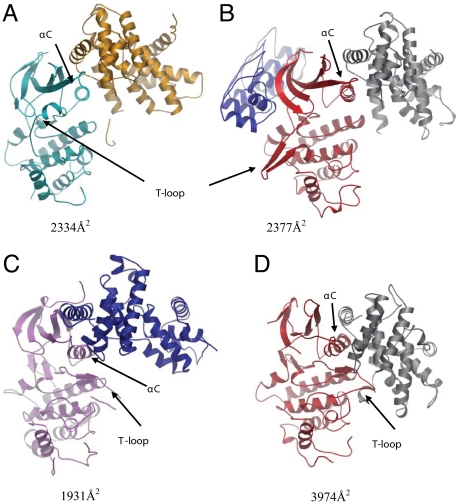Fig. 2.
Superpositions of various CDK/cyclin complexes or CDKs with CDK4/cyclin D1. Only the kinases were used for the superpositions and rmsd values are given (see Table S2 and Fig. S5). For clarity each panel shows an individual CDK/cyclin complex. (A) Ribbon diagram of the CDK4 (cyan)/cyclin D1(orange) complex. The αC-helix is viewed end on. It can be seen that cyclin D1 primarily contacts the N-lobe and αC-helix of CDK4. The buried surface area of the complex is 2,334 Å2. (B) CDK6 (red)/cyclin K (gray)/INK4c (blue) ternary complex (Protein Data Bank ID code 1G3N) (rmsd 0.888 Å). INK binding maintains the αC-helix in an inactive conformation, triggers a reconfiguration of the T-loop, and induces a rotation of the CDK6 N-lobe. Cyclin K mainly contacts the CDK6 N-lobe and αC-helix, resulting in a relatively small contact interface (2,377-Å2 buried surface area) compared with CDK/cyclin binary complexes (see D). Although the CDK6 N-lobe is rotated with respect to CDK4 the cyclin K and cyclin D1 are similarly engaged and disposed in each complex. (C) CDK9 (pink)/cyclin T1(blue) (Protein Data Bank ID code 3BLH) (rmsd 1.387 Å). Even though cyclin T1 only forms sparse contacts (buried surface area 1,931 Å2) with the kinase N-lobe the CDK αC-helix and T-loop adopt active conformations. The relative disposition of the CDK and cyclin deviate from the conformations typically seen in active CDK/cyclin complexes. (D) CDK6 (red)/ vCyclin (gray) (Protein Data Bank ID code 1JOW) (rmsd 1.114 Å). Although the kinases broadly overlay the relative disposition of their cognate cyclins is substantially different. The vCyclin engages with both the N- and C-terminal lobes of CDK6 and forms extensive contacts with the T-loop of CDK6. The CDK6 T-loop has a loop out conformation that is characteristic of a fully-activated CDK, as is the αC-helix conformation that is rotated to an in position. The buried surface area of the CDK6/vCyclin interface is 3,974 Å2. This is a high value for CDK/cyclin binary complexes and helps to explain how the viral cyclin is able to activate the CDK6 even in the absence of phosphorylation of the CDK6 T-loop.

